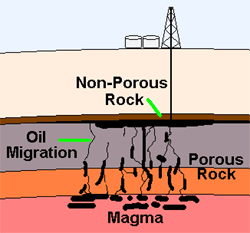 Fossils From Animals And Plants Are Not Necessary For Crude Oil And Natural Gas, Swedish Researchers Find
What would happen if it were proven that "fossil fuels" weren't the result of decaying plant and animal matter, were actually created within the Earth due to simple chemistry and you could not be scared into believing that we were "running out" of oil and natural gas? Estimates of how much crude oil we have extracted from the planet vary wildly. As late as May of 2009 a report published in the International Journal of Oil, Gas and Coal Technology suggested that we may have used more than we think. The idea that we are running out of oil is not a new one. Scientists have told us that oil is a limited resource which was formed millions of years ago by the decaying vegetation and biomass of extinct species of plants and animals. With an estimated 1- trillion barrels of oil already extracted from deep wells since commercial drilling began around 1870, many predict that we are nearing the mid-point of remaining oil on the planet. But there have always been those who claim that oil is a natural substance that forms automatically in the Earth's mantle. They say that it is virtually everywhere, if you can drill deep enough to tap it. Proponents of so-called "abiotic oil" claim that the proof is found in the fact that many capped wells, which were formerly dry of oil, are found to be plentiful again after many years, They claim that the replenished oil is manufactured by natural forces in the Earth's mantle.
Critics of the abiotic theory disagree. They claim that capped wells may appear to refill after a few years, but they are not regenerating. It is simply an effect of oil slowly migrating through pore spaces from areas of high pressure to the low-pressure area of the drill hole. If this oil is drawn out, it will take even longer for the hole to refill again. They hold that oil is a non-renewable resource generated and deposited under special biological and geological conditions. Until now these believers in "abiotic oil" have been dismissed as professing "bad science" but -- alas -- a new study has proven them correct! Reported in ScienceDaily, researchers at the Royal Institute of Technology (KTH) in Stockholm have managed to prove that fossils from animals and plants are not necessary for crude oil and natural gas to be generated. The findings are revolutionary since this means, on the one hand, that it will be much easier to find these sources of energy and, on the other hand, that they can be found all over the globe. "Using our research we can even say where oil could be found in Sweden," says Vladimir Kutcherov, a professor at the Division of Energy Technology at KTH. Together with two research colleagues, Vladimir Kutcherov has simulated the process involving pressure and heat that occurs naturally in the inner layers of the earth, the process that generates hydrocarbon, the primary component in oil and natural gas. According to Vladimir Kutcherov, the findings are a clear indication that the oil supply is not about to end, which researchers and experts in the field have long feared.
Vladimir Kutcherov adds that there is no way that fossil oil, with the help of gravity or other forces, could have seeped down to a depth of 10.5 kilometers in the state of Texas, for example, which is rich in oil deposits. As Vladimir Kutcherov sees it, this is further proof, alongside his own research findings, of the genesis of these energy sources -- that they can be created in other ways than via fossils. This has long been a matter of lively discussion among scientists. "There is no doubt that our research proves that crude oil and natural gas are generated without the involvement of fossils. All types of bedrock can serve as reservoirs of oil," says Vladimir Kutcherov, who adds that this is true of land areas that have not yet been prospected for these energy sources. But the discovery has more benefits. The degree of accuracy in finding oil is enhanced dramatically -- from 20 to 70 percent. Since drilling for oil and natural gas is a very expensive process, the cost picture will be radically altered for petroleum companies, and in the end probably for consumers as well. "The savings will be in the many billions," says Vladimir Kutcherov. To identify where it is worthwhile to drill for natural gas and oil, Vladimir Kutcherov has used his research to arrive at a new method. It involves dividing the globe into a finely meshed grid. The grid corresponds to fissures, so-called 'migration channels,' through underlying layers under the surface of the earth. Wherever these fissures meet, it is suitable to drill. According to Vladimir Kutcherov, these research findings are extremely important, not least as 61 percent of the world's energy consumption derives from crude oil and natural gas. The next step in this research work will involve more experiments, but above all refining the method will make it easier to find places where it is suitable to drill for oil and natural gas. Vladimir Kutcherov, Anton Kolesnikov, and Alexander Goncharov's research work was recently published in the scientific journal Nature Geoscience.

I just read a book about abiotic oil and the scientific evidence and politicalization of it. It's called, "Oil, The 4th Renewable Resource." the website is www.oilrenewables.com Check it out and see for yourself. Thanks for your hard work in researching this. Marissa
|
 The abiotic oil formation theory suggests that crude oil is the result of naturally occurring and possibly ongoing geological processes. This theory was developed in the Soviet Union during the Cold War, as the Union needed to be self sufficient in terms of producing its own energy. The science behind the theory is sound and is based on experimental evidence in both the laboratory and in the field. This theory has helped to identify and therefore develop large numbers of gas and oil deposits. Examples of such fields are the South Khylchuyu field and the controversial Sakhalin II field.
The abiotic oil formation theory suggests that crude oil is the result of naturally occurring and possibly ongoing geological processes. This theory was developed in the Soviet Union during the Cold War, as the Union needed to be self sufficient in terms of producing its own energy. The science behind the theory is sound and is based on experimental evidence in both the laboratory and in the field. This theory has helped to identify and therefore develop large numbers of gas and oil deposits. Examples of such fields are the South Khylchuyu field and the controversial Sakhalin II field.